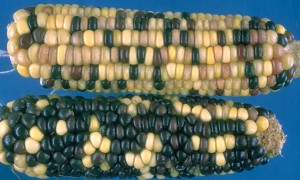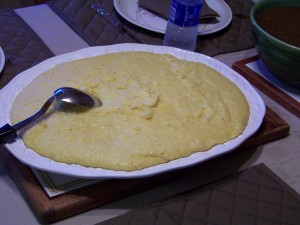MAT_kinase has sparked an interesting discussion about the associations people have with corn of different colors. I’d previously heard that yellow corn (where pre-vitamin A carotenoids are produced in the kernels) isn’t popular in Africa, with the reason usually being given as its association with American food aid.* If yellow corn comes predominantely from food aid, it eventually becomes associated with being poor and/or starving, so that when people have a choice they eat other varieties of corn. I can’t find where I read it, but I vividly remember reading an interview with a woman who talked about the shame of eating yellow food-aid corn, knowing that it had originally been intended to feed livestock in the US, not people.
MAT points out another more pragmatic reason yellow corn may not be favored in Africa that I hadn’t heard of before. Apparently the extra carotenoids make yellow corn more susceptiable to spoilage than white corn varieties, a very pertenent issue in areas without access to the kinds of storage facilities we take for granted in American agriculture.
Jeremy at the Agricultural Biodiversity Weblog picked up the torch, highlighting a number of their own previous posts relevant to the discussion, including one by fellow blogger Luigi that relates the reaction of his own wife, originally from Kenya, on ordering polenta** at a restuarant and receiving a yellow dish.
Fortunately breeds of corn that contain even more beta carotene (the carotenoid most easily converted into vitamin A by our bodies) aren’t even yellow all the time. Although I wasn’t able to find a freely available picture, sometimes they’re ORANGE.*** While it turns out the correlation between color and beta carotene content isn’t perfect****, there’s still reason to hope varieties bred for the highest pre-vitamin A content will end up a striking orange color. For a visual examples of how orange corn can get, check out check out Dr. Rocheford’s lab website.
Will the distinction between orange and yellow***** be enough to get over the Africa’s lack of enthusiasm for yellow corn? Will the benefits of a diet with more vitamin A be enough to outweight the issues with yellow corn going “off” if stored improperly? I certainly hope the answers to both these questions are yes, but we won’t know for sure until we try. And there are some hopeful signs. For example this segment in a story from NPR:
Winter-Nelson and one of his graduate students took some of this orange corn to an open-air market in Mozambique for a taste test. The market-goers still preferred their white corn, but almost half of them agreed to exchange it for bags of orange corn when they heard it was more nutritious.”Probably the most encouraging part of it for me was that people who reported that they didn’t have much dietary diversity,” Winter-Nelson says. “People who reported that they didn’t eat very many fruits and vegetables, [or] that they very rarely ate animal products of any kind — eggs, meat, or chicken — were the most likely to take the trade.
“So, the ones who need it were attracted to it.”
So that’s a hopeful sign.

Two ears where some kernels received C1 from both parents, some from one parent and some from none. In a whole field full of C1 homozygotes, almost the kernels would be dark purple/black. Image courtesy of MaizeGDB and MG Neuffer
As I was proofing this post today, one other thing occurred to me. If the objection to yellow corn is primarily based on the color (let’s leave aside the issue of flavor for a moment), wouldn’t the simplest solution for the biofortified corn be to breed in an allele like C1 that turns corn kernels purple/black? There’d be absolutely no chance of the corn being mistaken for normal yellow corn, and since C1 acts on the production of anthocyanins, a completely different kind of plant pigments, it shouldn’t impact the level of beta carotene in the biofortified corn. Please point out in the comments if I’ve missed something obvious.
*This isn’t to say the food aid itself is unpopular, only that people prefer not to eat corn that resembles it when they’re NOT starving.
**A dish made of boiled corn meal, see photo below. A few years ago my mother discovered a lasagna recipe that substituted well cooked polenta for lasagna nuddles. About which, all I can say is that if you otherwise couldn’t eat lasagna (for example people who avoid eating gluten found in grains like wheat, barley, and rye by choice or necessity), polenta lasagna is a lot better than no lasagna at all.
***The amazing genetic diversity of maize also means these varietes can be produced without the need for genetic engineering. Which means getting the seeds to those would could most benefit from them would be faster and cheaper than something like golden rice which governments will hopefully approve someday.
****Harjes, C.E., Rocheford, T.R., Bai, L., Brutnell, T.P., Kandianis, C.B., Sowinski, S.G., Stapleton, A.E., Vallabhaneni, R., Williams, M., Wurtzel, E.T., Yan, J.B. and Buckler, E.S. (2008). Natural genetic variation in lycopene epsilon cyclase tapped for maize biofortification. Science DOI: 10.1126/science.1150255
****It occurs to me one factor in whether the distinction between yellow and orange is important may turn out to be whether different local languages contain a word for orange. Languages have been studied that contain as few as two words for colors (roughly: dark and light) and a color name describing orange is almost never found in languages with less than 7 color names. … sorry a distribution requirements class that I had to take in college just became arguable relevant. This is exciting!

[…] corn colour stuff from […]
Pingback by Nibbles: Patents, Wheat value, Maize, Perennial crops, Mango killer — February 16, 2010 @ 2:09 am
An interesting post. One thing I’ve read is that traditionally Africans ate yellow and orange varieties of corn. During colonialism and particularly in South Africa, corn become a commodity and the standards shifted towards uniform white varieties for a number of market-driven reasons. That preference stuck so that white corn is now generally preferred over the traditional yellow types.
As new orange varieties of corn with higher amounts of beta-carotene are developed for Africa, consumer preference will also have to be taken into account. But experience with orange sweet potato in Africa has shown that people are willing to eat these new orange varieties once they are learn about and understand its nutritional benefits.
Comment by Yassir Islam — February 18, 2010 @ 2:04 pm
Fascinating! I hadn’t realized the preference for white corn in Africa was a historically recent event. Although I guess the whole history of maize in Africa can’t be more than what, five hundred years?
It’s strange to think that prior to the 1500s the Eastern hemisphere made do entirely without corn and potatoes, and I can’t imagine Indian and Thai cooking back then (without chili peppers).
Comment by James — February 18, 2010 @ 3:50 pm
Jame,s I was trying to look up the book on maize that discussed this, but i can’t recall it right now–if I do I’ll let you know. its fascinating that maize is now a farm more important food crop in Africa, than in mesoamerica where it originated.
Comment by Yassir Islam — February 19, 2010 @ 8:02 am
Thanks Yassir, I’ll be interested to give it a read if you remember the title.
I was just talking to a friend who is spending the semester in Costa Rica, and we were talking about how it was strange to think that in a place so close to where maize was first domesticated, almost all of her meals are based on rice instead.
Comment by James — February 19, 2010 @ 10:16 am
[…] But maybe these beneficiaries aren’t used to eating the yellow corn they are given because white corn is native to their land. Maybe the community does not actually need a new well to be built in their village because there […]
Pingback by The long and dusty road: The Power of Social Entrepreneurship | entrepreneurships.net — July 4, 2012 @ 12:57 pm